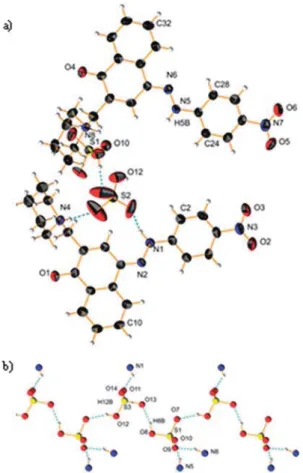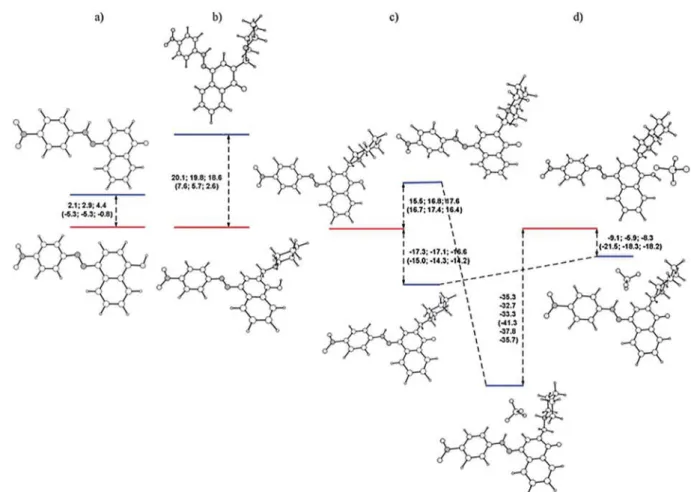Controlled tautomerism – switching caused by an
“ underground ” anionic e ff ect †
Liudmil Antonov,* a Vera Deneva, a Vanya Kurteva, a Daniela Nedeltcheva, a Aurelien Crochet b and Katharina M. Fromm b
In a previous communication, we demonstrated a conceptual idea for a tautomeric switching system based on implementation of a fl exible piperidine unit in 4-(phenyldiazenyl)naphthalen-1-ol (1). The results showed that a directed shift in the position of the tautomeric equilibrium can be achieved through protonation/deprotonation in a number of solvents. However, the e ff ect of the counter ion in the process of protonation was never considered. The crystallographic analysis of protonated cyano and nitro derivatives of 4-(phenyldiazenyl)-2-(piperidin-1-ylmethyl)naphthalen-1-ol have shown an interesting and unexpected feature: the counter ion is captured in the process of protonation and the shift in the position of the tautomeric equilibrium is achieved through a bridged complex formation. To the best of our knowledge this is a rare example when controlled shift in the position of tautomeric equilibrium is achieved through anion complexation. The results from the solid state analyses are confirmed by NMR spectroscopy in solution and by quantum-chemical calculations.
Introduction
The development of molecular devices is an exciting and promising idea,
2which might establish the necessary ground for a technological jump in the future. The concept is based on the use of single molecules as building “hardware” elements (wires, switches, rectiers, etc.) and their further suitable assembly into working devices by using chemical bonding or by intra-/intermolecular forces.
3The quest for nding such molecular level “hardware” has increased dramatically over the last decade
4and the main emphasis is given to organic and hybrid systems, because the wide range of molecular propen- sities can be combined with the versatility of synthetic chem- istry to alter and optimize molecular structure in the direction of desired properties.
Virtually, every single molecule changes its behavior when acted upon by external stimuli, but its use as a molecular switch is possible only if these changes are reproducible, reversible and can be explicitly controlled and monitored.
5There are many types of molecular switches known nowadays like photo- chromic systems, which are able to switch between electronic congurations when irradiated by light at a specic wavelength,
host-guest molecular switches in which the compound is able to take up cations aer a photochemical trigger and the most advanced ones – mechanically interlocked molecular switches, where the bistable states differ in the position of the macrocycle.
6The main requirement in the design of new molecular switches is to provide fast and clean interconversion between structurally different molecular (on- and off-) states. On one side, taking into account this requirement, the tautomerism could be a possible elemental process, because the change in the tautomeric state is accomplished by a fast proton transfer reaction between two or more structures, each of them with clear and different properties. On the other side, the real tautomerism, by itself, means practically uncontrollable shi in the equilibrium under changing local environment. It is impossible, in general, to achieve full shi from one to another individual tautomer in a controlled manner.
7Consequently, the main problem in developing tautomeric switching system is to provide conditions for a controlled shi of the tautomeric equilibrium in a way that the on- and off-states correspond to the individual tautomers. First really working example of such molecular switch was proposed in IBM Research-Zurich,
8where the switching is mediated by a tautomerization reaction of metal-free naphthalocyanine. Using a low-temperature scan- ning tunneling microscope, a voltage pulse at the STM tip can induce a change in the orientation of the hydrogen atom-pair at the center of naphthalocyanine, leading to tautomeric switch- ing between low and high conductance.
Another type of tautomeric switching systems, based on azodyes, have been reported to work in solution using number
a
Institute of Organic Chemistry with Centre of Phytochemistry, Bulgarian Academy of Sciences, Acad. G. Bonchev str., bl.9, BG-1113 Soa, Bulgaria. E-mail: lantonov@
orgchm.bas.bg
b




